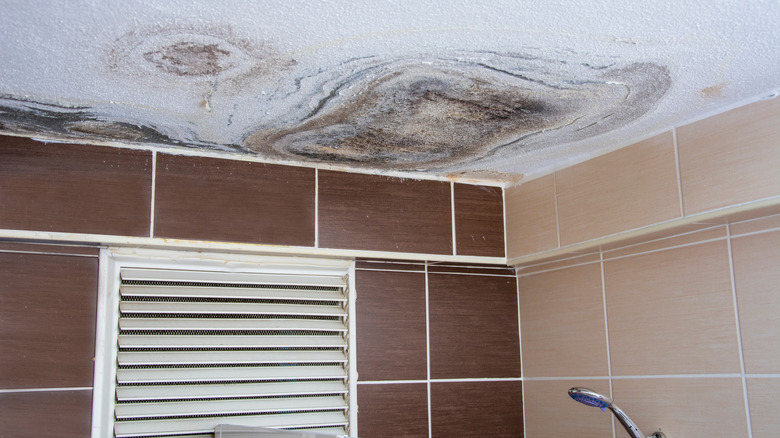Concerning Reasons Why Mold Is Growing On Your Ceiling
Dealing with mold can be quite frustrating. While there are many easy ways to clean it up, finding those dreaded fungi on your ceiling may indicate more concerning issues. Typically, causes of ceiling mold can be broadly differentiated into two main categories: humidity- and liquid-based moisture. To effectively deal with either, you need to know what exactly led to it.
Humidity-based molds are linked to increased humidity levels in a room. When the moisture-filled air comes in contact with a cold ceiling, it condenses on the surface, creating a great environment for fungal growth. Humidity can drive mold development through poor ventilation, insulation damage, and plants (which create humidity through transpiration. On the other hand, liquid-based causes lead to direct water exposure to the ceiling. Plumbing issues and roof leaks fall into this category.
Problems that expose your ceiling to water are typically much more dire than those caused by high humidity. This is because roof leaks or plumbing damage can spell much more than mold infestation and also be tell-tale signs of structural damage, wood rot, pest infestations, foundation issues, and so on. With these kinds of complications, you're not just looking at identifying and getting rid of the mold. You'll also have to call roofing or plumbing experts to find the source of the leak and determine if there's any structural damage.
Ceiling mold from roof leaks or plumbing issues
Believe it or not, 24 hours is all it takes for a leaky roof to create perfect conditions for mold growth, and it causes two types: limited and systemic. With limited growth, you'll only notice ceiling mold in the area around the leak. This type of development happens in rooms with leaky roofs but adequate ventilation that balances the humidity level, reducing the chance of more fungal spread. Systemic growth occurs when there's a leak in areas with poor ventilation. The increased moisture in the air will condense on available areas on the ceiling, and over time, the whole surface will experience considerable mold development. This typically happens in attics or bathrooms.
Ceiling mold caused by plumbing problems is more prevalent in houses with multiple floors. A broken or leaking pipe on one level could cause fungi to develop on the ceiling below. Grout issues in a bathroom or laundry room on a higher level are a danger too. Water can seep between the tiles and under the floor, pooling on the ceiling below and driving mold proliferation.
These liquid-based problems are notorious for hidden mold. In most cases, large-scale growth has already spread between the roof and the underside of the ceiling long before you even notice any streaks. You shouldn't try handling mold caused by these kinds of issues yourself. Professionals know the best way to tackle them and prevent reoccurrence.
Humidity-based causes
Ceiling mold is more commonly caused by humidity issues, and thankfully, they don't usually come with the possibility of hidden fungi or other structural problems. Also, handling them may not necessarily require the help of a professional. Depending on the scale of the infestation, you could easily remove the mold with DIY solutions.
Let's start with the most popular perpetrator: Insufficient ventilation and airflow. When rooms with high humidity levels (like bathrooms and kitchens) don't have adequate ventilation, mold growth is almost inevitable. If you don't have an exhaust fan or vent or there's not enough fresh air to replace moisture-laden indoor gas, water can condense on the ceiling and create your fungi problem. Plants near or in contact with the ceiling can also lead to mold due to transpiration. Basically, overwatered houseplants can release water vapor into the air, producing the dreaded increase in humidity levels that can eventually attract mold to your ceiling. Spoilt insulation can cause growth in humid spaces even if they're well-ventilated. If there is an area on your ceiling with damaged insulation, it could create a cold spot in chilly weather. This is where the water in the air can condense and attract mold.
How to deal with ceiling mold
The first step in dealing with ceiling mold is identifying the cause of the growth. Note that fungi from liquid-based problems typically form a rippling pattern, radiating from the leaking spot. If you notice growth in a room with good airflow or under a bathroom, that's a telltale sign that your problem might be caused by a roof leak, plumbing issue, or damaged insulation. The culprit could also be a hidden leak. These are frustrating because without finding the source, you will keep fighting a losing battle with the mold in your home. When dealing with ceiling mold arising from roof leaks, plumbing, and even insulation problems, always hire a professional to ascertain the exact cause of the growth and the extent of damage and to advise you on the best next steps.
If you've checked thoroughly and can't find any issues related to direct water exposure, then it's likely the ceiling mold is caused by increased humidity. Now you can easily get rid of it with DIY solutions or commercially available fungicides. Afterward, tackle the humidity issues in your home so the mold doesn't come back. Using dehumidifiers, opening windows, installing exhaust fans, and ensuring your HVAC system is working properly are key ways to keep your humidity levels below the mold-friendly 60%. Also, avoid overwatering your plants and trim them away from the ceiling.



